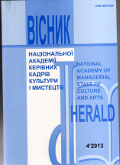The interpretation of the mythopoeia in Ukrainian art
DOI:
https://doi.org/10.32461/2226-3209.4.2013.138027Keywords:
archetype, interpretation, mythopoeia, symbol, Ukrainian artAbstract
In the contemporary art there is a strong tendency of returning to the archetype imagery, which is sometimes seen as a means of finding one’s origin and identity in the globalized world. The archetypal images are sometimes generated by author’s subconsciousness, but, perhaps, more often are borrowed from the folklore tradition, which includes some very ancient mythopoetic elements. Ukrainian artists have always widely used the folklore motifs, either inherited or reconstructed. Among the most important ethnic archetypes are usually mentioned Sky, Earth, Word, Mother, House etc; the main archetypal ideas are Sophinity, Cordocentrism, Antheism. Being transcendental, archetype can be present in the work of art only as an archetypal image or symbol, that combines the universal with the concrete and unique. That’s why a real work of art must not copy the existing examples, but re-create a myth. It is a very difficult task, as such a work of art must be believed into, it must explain the world and state the cardinal values for a person and a nation. Some Ukrainian artists successfully coped with this difficult task. Others were not so ambitious, but also used numerous folk motifs to achieve the higher level of generalization. So quite a number of the works can be seen as the artistic interpretations of the mythopoetic. The mythopoetic Cosmic structures have influenced the themes and imagery of Ukrainian musicians, artists, and writers. In music there are numerous arrangements of the folk melodies, including those of the ritual songs. In painting there are both pictures on the folklore subjects and those endowing the commonplace objects with the archetypal quality. Perhaps the most interesting case is the complex of works by Taras Shevchenko. He was not only a poet and writer, but an artist able not only to depict different aspects of the folk life, but to show in one picture the synthetic image of "Ukraineness" (Katerina). He is often called the creator of Ukrainian national identity, and with good reason. It is true, because his works defined the past, the present and the possible future of the group of people with the language, mentality and self-consciousness so distinct, that it was no longer possible to honestly consider Ukrainians to be an ethnic variety of Russians. Almost all the succeeding Ukrainian writers and artists followed his example. And even the authors whose main works are written in Russian, as is the case with M. Gogol, made a contribution in the development of the national idea, as they implied the history, mentality and self-identification of Ukrainians quite different from those of other nations of the Russian empire. The most typical feature of the mythopoetic in literature is the multi-level symbolism that allows seeing the deeper senses behind the life-like pictures. The most vivid examples include G.Skovoroda’s artistic philosophy, T.Shevchenko’s myth-making and Lesya Ukrainka’s folklore reimagining. If Shevchenko was concerned with the social and the national, Lesya Ukrainka, the other outstanding Ukrainian myth-maker, showed a very different ability as she depicted the inner conflict of the soul. Her main work is also full of strikingly modern ecological insights. In the historical genre the writers sometimes depict the irrational bases of the ethnic culture. We can take as an example of showing the hidden inner world of the nation the different interpretations of the phenomenon of "Kharakternitstvo" (Cossack battle magic). In mid XIX ct P. Kulish in his Black Council depicted a Kharakternik as a person who is supposed to have some magic skills, which the author neither denies nor confirms. One hundred years later O. Ilchenko wrote a novel that can be classified as an example of the Magical Realism, where the hero clearly has supernatural abilities. In the art of the new millennium Kharacternitstvo can be depicted both as a strict historical truth, and as a pretext for the patently incredible steampunk-like adventures (as in the internationally prized graphic novel Daogopak). On the other hand, there are such works that avoid the showy effects but create the atmosphere of the pastas-eternal, as in O. Sanin’s film Mamai. Anyway, in almost all the cases the theme of Cossak-warlock is treated as a very important and very evocative for Ukrainian public. Rather typical for World and Ukrainian art is the re-creation of the myth-like elements in fantasy. The techniques differ. Sometimes it is a modern retelling of a folk story. In the genre of the Urban fantasy there is an example of complex mythologisation of a city with its multi-level history (as in Lada Lusina’s cycle Kyiv Witches). Generally the works of Ukrainian writers of different genres tend to depict a meaningful, well-structured, harmonious Cosmos. But the historical facts and the modern state of affairs result in that one of the most typical motifs is a destruction of this harmony that people must take care to overcome.Downloads
Published
Issue
Section
License
Authors who publish with this journal agree to the following terms:
1. Authors retain copyright and grant the journal right of first publication with the work simultaneously licensed under a Creative Commons Attribution License International CC-BY that allows others to share the work with an acknowledgement of the work's authorship and initial publication in this journal.
2. Authors are able to enter into separate, additional contractual arrangements for the non-exclusive distribution of the journal's published version of the work (e.g., post it to an institutional repository or publish it in a book), with an acknowledgement of its initial publication in this journal.
3. Authors are permitted and encouraged to post their work online (e.g., in institutional repositories or on their website) prior to and during the submission process, as it can lead to productive exchanges, as well as earlier and greater citation of published work (See The Effect of Open Access).


